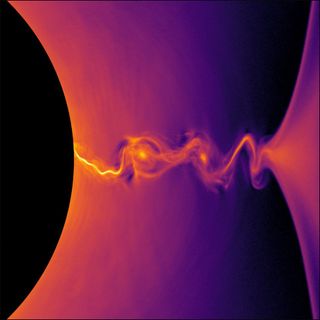what does the rest of the universe look like to someone near a black hole
What Exactly Is a Black Hole Outcome Horizon (and What Happens There)?

On Wednesday (Apr 10), the international Outcome Horizon Telescope project will release the commencement results from its plan to image black holes. But what exactly is an event horizon?
The event horizon of a black hole is linked to the object'due south escape velocity — the speed that i would need to exceed to escape the blackness hole'south gravitational pull. The closer someone came to a black hole, the greater the speed they would need to escape that massive gravity. The effect horizon is the threshold around the blackness hole where the escape velocity surpasses the speed of light.
Co-ordinate to Einstein's theory of special relativity, nothing can travel faster through infinite than the speed of calorie-free. This means a blackness pigsty'southward event horizon is essentially the point from which cypher tin render. The name refers to the impossibility of witnessing any consequence taking place inside that edge, the horizon beyond which one cannot see.
Related: 'Groundbreaking Upshot' Coming Soon from Event Horizon Telescope
"The event horizon is the ultimate prison wall — one can make it simply never get out," Avi Loeb, chair of astronomy at Harvard University, told Space.com.
When an item gets near an event horizon, a witness would come across the detail's paradigm redden and dim as gravity distorted light coming from that particular. At the result horizon, this image would effectively fade to invisibility.
Within the event horizon, one would observe the blackness hole's singularity, where previous research suggests all of the object's mass has collapsed to an infinitely dense extent. This means the fabric of space and time around the singularity has also curved to an infinite degree, so the laws of physics equally we currently know them intermission downwards.
"The event horizon protects us from the unknown physics near a singularity," Loeb said.
Related: Images: Black Holes of the Universe
The size of an event horizon depends on the black hole'due south mass. If Earth were compressed until information technology became a black hole, it would have a bore of about 0.69 inches (17.four millimeters), a little smaller than a dime; if the sun were converted to a blackness hole, it would be nigh iii.62 miles (5.84 kilometers) wide, about the size of a village or boondocks. The supermassive black holes that the Event Horizon Telescope is observing are far larger; Sagittarius A*, at the center of the Milky Way, is about 4.iii one thousand thousand times the mass of our lord's day and has a diameter of about seven.nine million miles (12.vii million km), while M87 at the heart of the Virgo A galaxy is about 6 billion solar masses and 11 billion miles (17.vii billion km) wide.
The forcefulness of a black hole's gravitational pull depends on the distance from it — the closer you are, the more than powerful the tug. But the effects of this gravity on a company would differ depending on the black hole's mass. If you fell toward a relatively small black hole a few times the mass of the lord's day, for example, you would get pulled apart and stretched out in a process known every bit spaghettification, dying well before you reached the event horizon.
However, if you lot were to autumn toward a supermassive black hole millions to billions of times the mass of the sun, y'all wouldn't "feel such forces to a significant caste," Loeb said. You would not die of spaghettification earlier you crossed the event horizon (although numerous other hazards around such a black hole might impale y'all before you reached that betoken).
Blackness holes likely spin considering the stars they more often than not originate from also spun and because the thing they consume whirled in spirals before it fell in. Contempo findings suggest that black holes can rotate at speeds greater than ninety percent that of light, Loeb said.
Related: Black Hole Quiz: How Well Do Yous Know Nature'due south Weirdest Creations?
Previously, the virtually bones model of blackness holes assumed they did not spin, and and then their singularities were assumed to be points. But because black holes generally rotate, electric current models suggest their singularities are infinitely thin rings. This leads the event horizons of rotating blackness holes, also known every bit Kerr blackness holes, to appear oblong — squashed at the poles and bulging at their equators.
A rotating black hole's event horizon separates into an outer horizon and an inner horizon. The outer result horizon of such an object acts like a indicate of no render, just like the issue horizon of a nonrotating black hole. The inner event horizon of a rotating black hole, as well known every bit the Cauchy horizon, is stranger. By that threshold, cause no longer necessarily precedes effect, the past no longer necessarily determines the future, and time travel may be possible. (In a nonrotating black hole, also known as a Schwarzschild black hole, the inner and outer horizons coincide.)
A spinning black hole also forces the cloth of space-time around it to rotate with it, a phenomenon known as frame dragging or the Lense-Thirring effect. Frame dragging is also seen effectually other massive bodies, including Earth.
Frame dragging creates a cosmic whirlpool known as the ergosphere, which occurs exterior a rotating black hole'due south outer event horizon. Whatsoever object within the ergosphere is forced to move in the aforementioned direction in which the blackness hole is spinning. Matter falling into the ergosphere can get enough speed to escape the blackness hole's gravitational pull, taking some of the black pigsty's energy with it. In this manner, black holes can have powerful effects on their surroundings.
Rotation can also make black holes more effective at converting any matter that falls into them into energy. A nonrotating black hole would convert about 5.vii percent of an infalling object's mass into energy, following Einstein's famous equation E = mc^2. In contrast, a rotating black hole could catechumen up to 42 pct of an object'due south mass into energy, scientists accept adamant
Related: The Strangest Black Holes in the Universe
"This has important implications for the environments around black holes," Loeb said. "The amount of energy from the supermassive black holes at the centers of nigh all large galaxies can significantly influence the evolution of those galaxies."
Contempo piece of work has greatly upset the conventional view of black holes. In 2012, physicists suggested that annihilation falling toward a blackness hole might run into "firewalls" at or in the vicinity of the result horizon that would incinerate any matter falling in. This is because when particles collide, they can become invisibly connected through a link called entanglement, and black holes could intermission such links, releasing incredible amounts of energy.
Notwithstanding, other research seeking to unite general relativity, which tin can explicate the nature of gravity, with quantum mechanics, which tin describe the behavior of all known particles, suggests that firewalls may not be — considering event horizons themselves may not exist. Some physicists suggest that instead of abysses from which nothing can return, what nosotros currently call back of every bit black holes may actually be a range of blackness-hole-like objects that lack event horizons, such equally so-called fuzzballs, Loeb said.
By imaging the edges of blackness holes, the Outcome Horizon Telescope can aid scientists analyze the shapes and behaviors of event horizons.
"We can employ these images to constrain any theory on the structure of blackness holes," Loeb said. "Indeed, the fuzzball speculation — where the consequence horizon is not a sharp boundary, only is rather fuzzy — could exist tested with images from the Effect Horizon Telescope."
- Astronomers to Peer into a Black Hole for 1st Time with Event Horizon Telescope
- This Huge Blackness Pigsty Is Spinning at Half the Speed of Light!
- 8 Baffling Astronomy Mysteries
Follow Charles Q. Choi on Twitter @cqchoi . Follow us on Twitter. Follow u.s. on Twitter @Spacedotcom or Facebook .
Join our Infinite Forums to keep talking space on the latest missions, night sky and more! And if y'all take a news tip, correction or annotate, let united states of america know at: community@space.com.
gonzalestworaverefor.blogspot.com
Source: https://www.space.com/black-holes-event-horizon-explained.html

0 Response to "what does the rest of the universe look like to someone near a black hole"
Postar um comentário